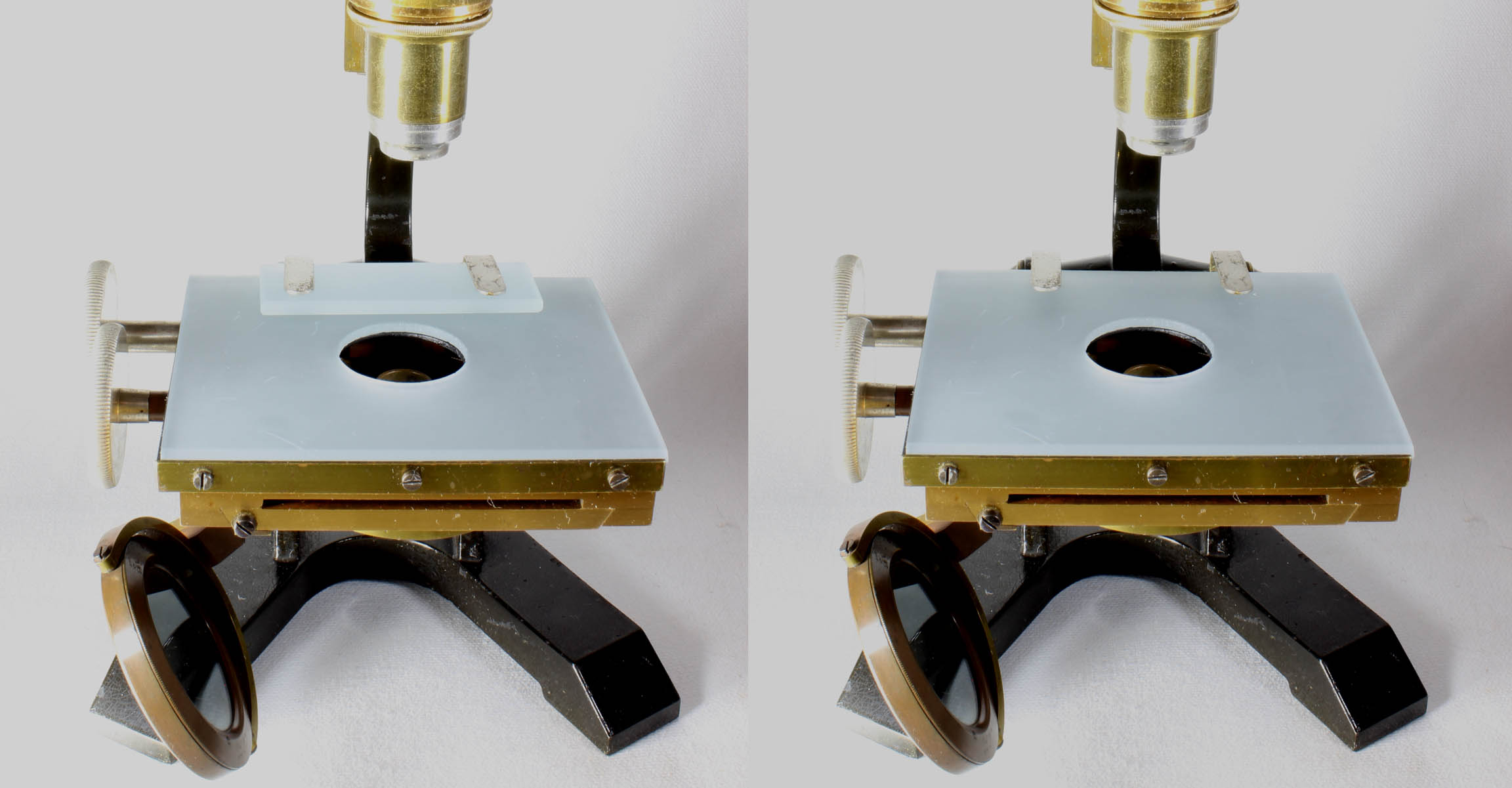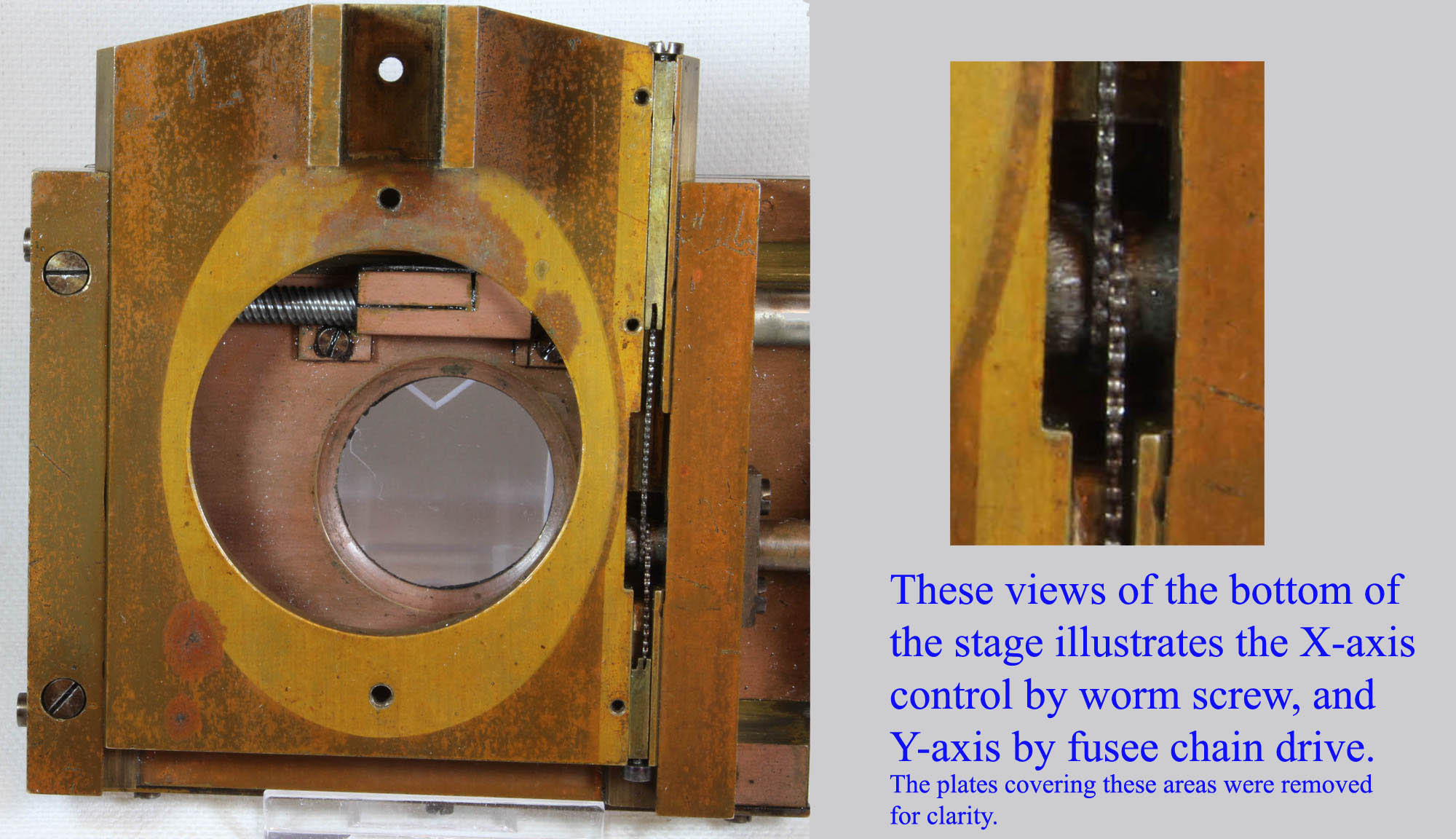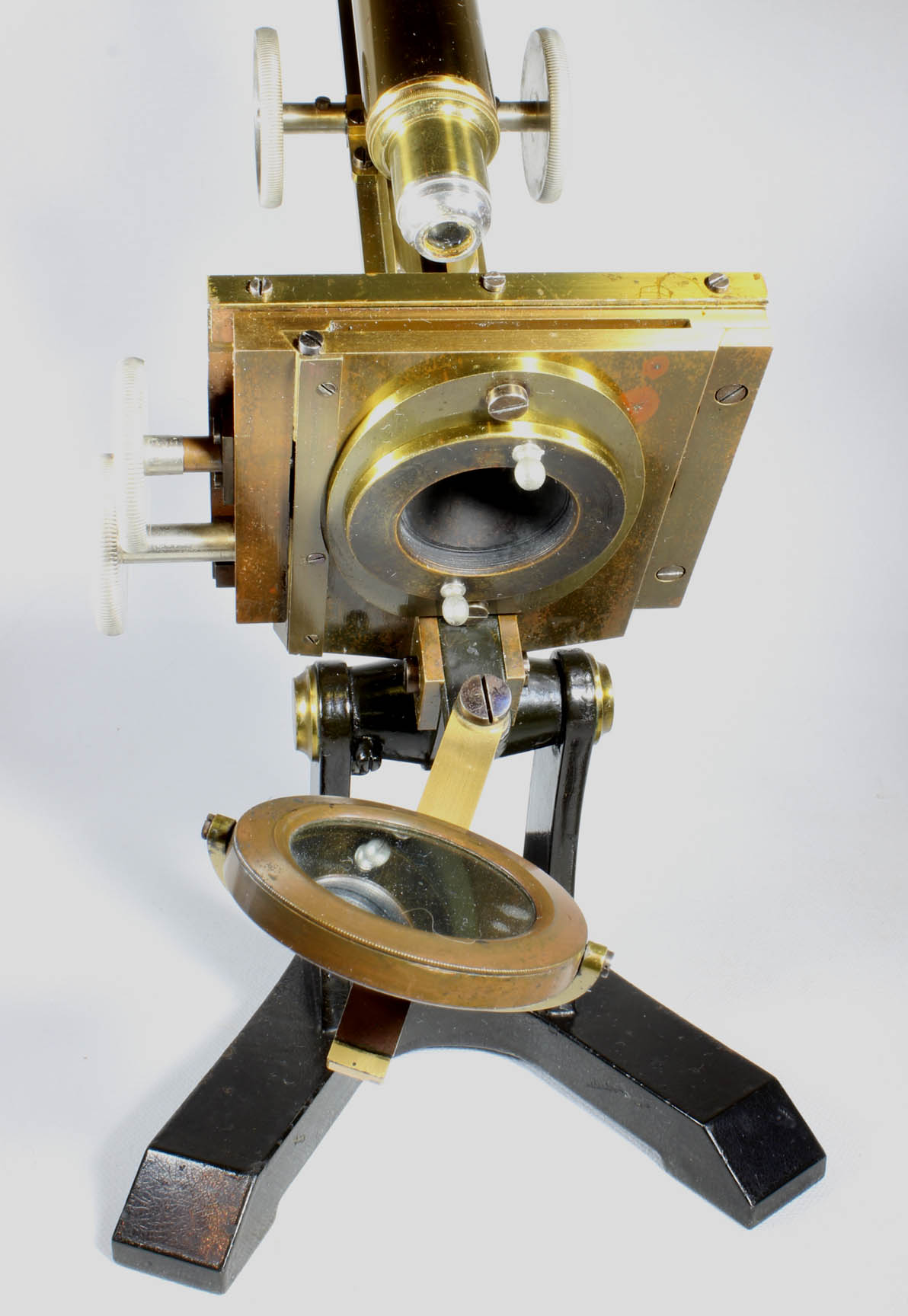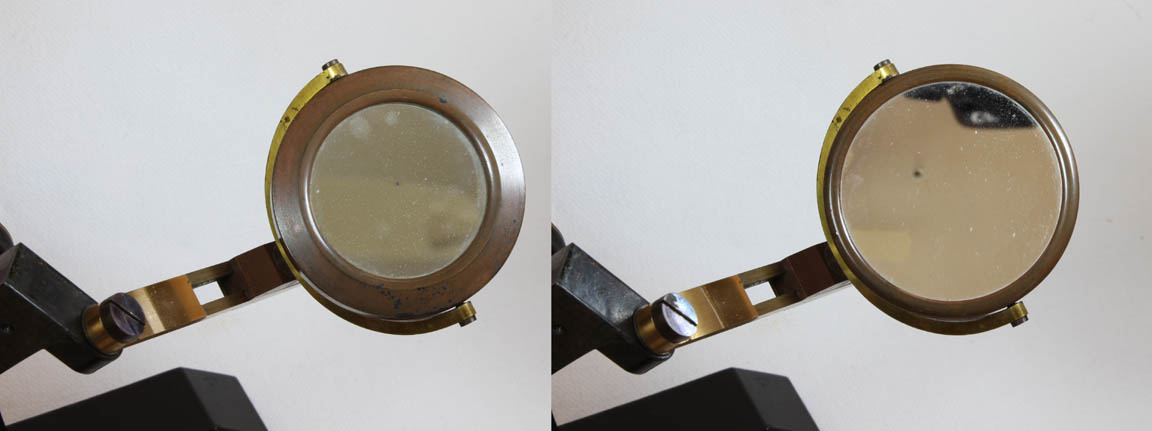MICROSCOPE-ANTIQUES.COM © 2013-21.
Grunow Microscope Stage and Substage Details
 The stage has a frosted glass plate which slips from the left side into grooves on the stage clips in back, and a brass ledge screwed into the front of the stage.
The stage clips are one of the unusual features in that they are not intended to hold a slide but rather other pieces of apparatus. Shown here is a thick frosted glass support which a slide would rest in front of; this small thick piece could be removed and be replaced, for example, by a live box or trough.
The stage has a frosted glass plate which slips from the left side into grooves on the stage clips in back, and a brass ledge screwed into the front of the stage.
The stage clips are one of the unusual features in that they are not intended to hold a slide but rather other pieces of apparatus. Shown here is a thick frosted glass support which a slide would rest in front of; this small thick piece could be removed and be replaced, for example, by a live box or trough.
 The stage is screwed into the limb as a saddle fitting with a screw from each side. The mechanical stage controls are nickel plated brass. Control of the stage is unusual in that the X-direction is controlled by worm screw, and the Y-direction by fusee chain drive. The fusee chain is 0.55 mm wide and 0.25 mm high. Each link is 1.77 mm long. There are two attachments for the chain one in the front of the stage and one on the back end. Each of these can be adjusted to change the tension on the chain. The chain is wraped around the control axle twice. Although shown intact in these images, it subsequently broke, as many of these do. This type of movement avoids backlash, but they were prone to require periodic adjustment, to rust, and to break.
The stage is screwed into the limb as a saddle fitting with a screw from each side. The mechanical stage controls are nickel plated brass. Control of the stage is unusual in that the X-direction is controlled by worm screw, and the Y-direction by fusee chain drive. The fusee chain is 0.55 mm wide and 0.25 mm high. Each link is 1.77 mm long. There are two attachments for the chain one in the front of the stage and one on the back end. Each of these can be adjusted to change the tension on the chain. The chain is wraped around the control axle twice. Although shown intact in these images, it subsequently broke, as many of these do. This type of movement avoids backlash, but they were prone to require periodic adjustment, to rust, and to break.
 Under the stage, attached by a bayonet fitting, is a support for one of the three included central stops. This bayonet fitting could be removed to allow more oblique lighting, taking advantage of the swinging tailpiece attached to the front edge of the bottom of the limb. The mirror is a typical Grunow type with one side carrying a (smaller diameter) concave mirror, while the other side carries a larger flat mirror. This feature, is similar to the type found on many Chevalier microscopes made in France.
Under the stage, attached by a bayonet fitting, is a support for one of the three included central stops. This bayonet fitting could be removed to allow more oblique lighting, taking advantage of the swinging tailpiece attached to the front edge of the bottom of the limb. The mirror is a typical Grunow type with one side carrying a (smaller diameter) concave mirror, while the other side carries a larger flat mirror. This feature, is similar to the type found on many Chevalier microscopes made in France. 
 The stage has a frosted glass plate which slips from the left side into grooves on the stage clips in back, and a brass ledge screwed into the front of the stage.
The stage clips are one of the unusual features in that they are not intended to hold a slide but rather other pieces of apparatus. Shown here is a thick frosted glass support which a slide would rest in front of; this small thick piece could be removed and be replaced, for example, by a live box or trough.
The stage has a frosted glass plate which slips from the left side into grooves on the stage clips in back, and a brass ledge screwed into the front of the stage.
The stage clips are one of the unusual features in that they are not intended to hold a slide but rather other pieces of apparatus. Shown here is a thick frosted glass support which a slide would rest in front of; this small thick piece could be removed and be replaced, for example, by a live box or trough.  The stage is screwed into the limb as a saddle fitting with a screw from each side. The mechanical stage controls are nickel plated brass. Control of the stage is unusual in that the X-direction is controlled by worm screw, and the Y-direction by fusee chain drive. The fusee chain is 0.55 mm wide and 0.25 mm high. Each link is 1.77 mm long. There are two attachments for the chain one in the front of the stage and one on the back end. Each of these can be adjusted to change the tension on the chain. The chain is wraped around the control axle twice. Although shown intact in these images, it subsequently broke, as many of these do. This type of movement avoids backlash, but they were prone to require periodic adjustment, to rust, and to break.
The stage is screwed into the limb as a saddle fitting with a screw from each side. The mechanical stage controls are nickel plated brass. Control of the stage is unusual in that the X-direction is controlled by worm screw, and the Y-direction by fusee chain drive. The fusee chain is 0.55 mm wide and 0.25 mm high. Each link is 1.77 mm long. There are two attachments for the chain one in the front of the stage and one on the back end. Each of these can be adjusted to change the tension on the chain. The chain is wraped around the control axle twice. Although shown intact in these images, it subsequently broke, as many of these do. This type of movement avoids backlash, but they were prone to require periodic adjustment, to rust, and to break.  Under the stage, attached by a bayonet fitting, is a support for one of the three included central stops. This bayonet fitting could be removed to allow more oblique lighting, taking advantage of the swinging tailpiece attached to the front edge of the bottom of the limb. The mirror is a typical Grunow type with one side carrying a (smaller diameter) concave mirror, while the other side carries a larger flat mirror. This feature, is similar to the type found on many Chevalier microscopes made in France.
Under the stage, attached by a bayonet fitting, is a support for one of the three included central stops. This bayonet fitting could be removed to allow more oblique lighting, taking advantage of the swinging tailpiece attached to the front edge of the bottom of the limb. The mirror is a typical Grunow type with one side carrying a (smaller diameter) concave mirror, while the other side carries a larger flat mirror. This feature, is similar to the type found on many Chevalier microscopes made in France. 